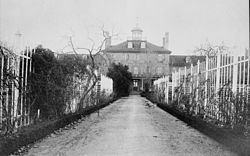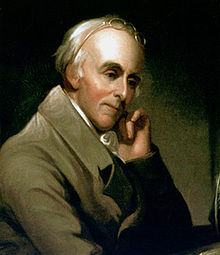Related Topics
Philadelphia Physicians
Philadelphia dominated the medical profession so long that it's hard to distinguish between local traditions and national ones. The distinctive feature is that in Philadelphia you must be a real doctor before you become a mere specialist.
Philadelphia Medicine (2)
Philadelphia is where medicine began in America
Right Angle Club 2012
This ends the ninetieth year for the club operating under the name of the Right Angle Club of Philadelphia. Before that, and for an unknown period, it was known as the Philadelphia Chapter of the Exchange Club.
Lazaretto

|
| David Barnes |
DAVID Barnes, professor at the University of Pennsylvania, kindly visited the Right Angle Club with an interesting talk about the Lazaretto, the oldest quarantine station in the Western hemisphere, and the sixth oldest in the world. It was built in 1800 responding to the Yellow Fever epidemic of 1793, followed by those of 1797, 1798, 1799, 1820, 1853, and 1870. If an incoming ship had a case of Yellow Fever on board, the patient was institutionalized at the Lazaretto and the ship captain had to pay for the care until the patient recovered, or until he didn't. Since we now know that Yellow Fever is transmitted by mosquito bites, it probably didn't do much good, and by locating the Lazaretto in a swamp, it may actually have promoted the spread of the disease. It thus fits into the story of Dr. Benjamin Rush hastening the death of his Yellow Fever patients by bleeding them of several pints of blood, as well as the construction of the Philadelphia Water Works to purify the drinking water, which we can now she had nothing to do with the disease, either. However, the waterworks were a marvel of engineering and must have saved many lives from Typhoid Fever. As recently as 1970, I can remember cases of anthrax being brought to the port on Pakistani ships, so quarantining and quarantine stations are useful ideas, some of the time.

|
| Philadelphia Lazaretto |
The first Lazaretto was built on the Aegean Sea at Venice, around 1450. There is some dispute about the name, which is said to come from the patron saint of lepers, St. Lazarus. The followers of St. Nazareth maintain the present name is a corruption of Nazaretto however, since St. Lazarus was the name of the church on the island where it stands. It seems most likely that the original Venetian quarantine hospital was responding to the plague, which would have benefitted greatly from isolation, although the rats and mice probably quickly found a way around their problem. Benjamin Rush thought that Yellow Fever was transmitted by the overpowering stench of rotting coffee beans, which is quite wrong as Walter Reed later showed, but at least it would lead to the idea that quarantine might be useful. Historically, the rumors and suppositions about this matter were useful to the Virginia delegates to the Constitutional Convention, who used it to promote their campaign to move the national capital to Washington, D.C.
The Schuylkill empties into the Delaware River at a sharp bend in Delaware, which slows the river and causes silt to be dumped there. William Penn had earlier decided to locate his new colony at Chester, just below the bend. However, he soon saw that it was more defensible to locate Philadelphia on the upstream side of the mud flats, as it proved to be in the Revolutionary War. Fort Mifflin was located just above the mud flats and could be kept supplied by flatboats coming down the Schuylkill from Valley Forge and Reading, the arsenal city of the Revolution. On Benjamin Franklin's suggestion, the channels between the mud flats were blocked by the chevaux de fries, underwater spiked contraptions which were much like the blockages to the entrance of parking lots. On the Jersey side of Delaware was Ft. Mercer at what is now called National Park. It was a formidable defense which almost ended the War by starving the British troops who had occupied Philadelphia from the rear via Germantown but were long unable to get past Fort Mifflin with their fleet, coming upriver. Most of South Philadelphia was a swamp, and there are many reports of flocks of swans paddling around the entrance of the Schuylkill. Hog Island became a shipyard, then a Naval Base. And then the airport was built on the mudflats, pretty much-obliterating everything else. There is the talk of making this area into the main intermodal transportation hub of the east coast, since ocean shipping, air transport, interstate highways, and railroad are all crowded together, quite close to the urban centers.

|
| Benjamin Rush |
Benjamin Rush, a signer of the Declaration of Independence, was still active at the Pennsylvania Hospital in 1800. It was still the only general hospital in America and the model for much of subsequent American medicine. One striking memento of that connection at the Lazaretto is the cupola on the center building, which is very similar to the cupulas on the roof of the building at 8th and Spruce Streets. The brickwork is also Flemish bond. The ten-acre site of the Lazaretto is very accessible, except perhaps for the suspicious Tinicum Township police. However, it has long been a tradition to have a banquet and picnic at the Lazaretto at the beginning and end of the quarantine season, roughly June 1, and October 1. Yellow Fever shots are not required.
Originally published: Saturday, July 14, 2012; most-recently modified: Thursday, May 23, 2019
| Posted by: ct | May 7, 2013 9:55 PM |